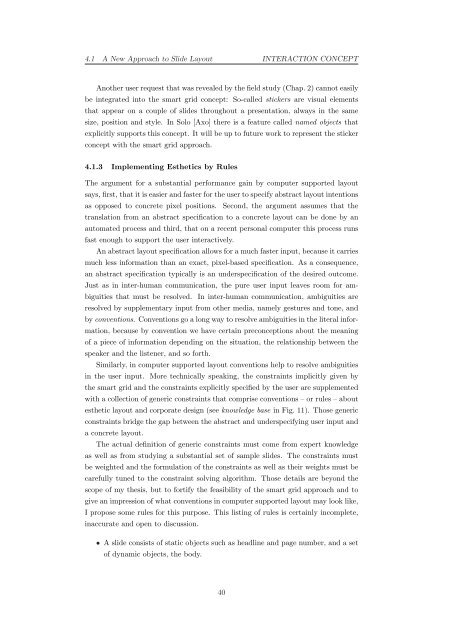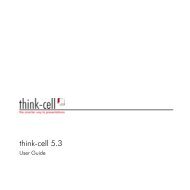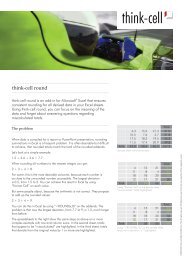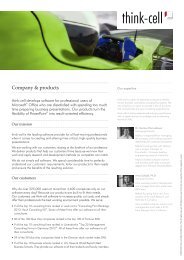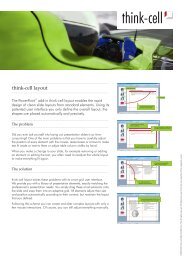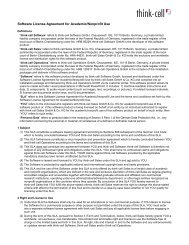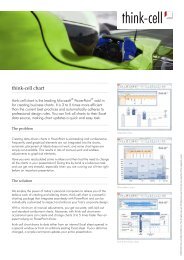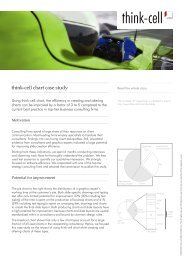think-cell technical report TC2003/01 A GUI-based Interaction ...
think-cell technical report TC2003/01 A GUI-based Interaction ...
think-cell technical report TC2003/01 A GUI-based Interaction ...
You also want an ePaper? Increase the reach of your titles
YUMPU automatically turns print PDFs into web optimized ePapers that Google loves.
4.1 A New Approach to Slide Layout INTERACTION CONCEPT<br />
Another user request that was revealed by the field study (Chap. 2) cannot easily<br />
be integrated into the smart grid concept: So-called stickers are visual elements<br />
that appear on a couple of slides throughout a presentation, always in the same<br />
size, position and style. In Solo [Axo] there is a feature called named objects that<br />
explicitly supports this concept. It will be up to future work to represent the sticker<br />
concept with the smart grid approach.<br />
4.1.3 Implementing Esthetics by Rules<br />
The argument for a substantial performance gain by computer supported layout<br />
says, first, that it is easier and faster for the user to specify abstract layout intentions<br />
as opposed to concrete pixel positions. Second, the argument assumes that the<br />
translation from an abstract specification to a concrete layout can be done by an<br />
automated process and third, that on a recent personal computer this process runs<br />
fast enough to support the user interactively.<br />
An abstract layout specification allows for a much faster input, because it carries<br />
much less information than an exact, pixel-<strong>based</strong> specification. As a consequence,<br />
an abstract specification typically is an underspecification of the desired outcome.<br />
Just as in inter-human communication, the pure user input leaves room for am-<br />
biguities that must be resolved. In inter-human communication, ambiguities are<br />
resolved by supplementary input from other media, namely gestures and tone, and<br />
by conventions. Conventions go a long way to resolve ambiguities in the literal infor-<br />
mation, because by convention we have certain preconceptions about the meaning<br />
of a piece of information depending on the situation, the relationship between the<br />
speaker and the listener, and so forth.<br />
Similarly, in computer supported layout conventions help to resolve ambiguities<br />
in the user input. More <strong>technical</strong>ly speaking, the constraints implicitly given by<br />
the smart grid and the constraints explicitly specified by the user are supplemented<br />
with a collection of generic constraints that comprise conventions – or rules – about<br />
esthetic layout and corporate design (see knowledge base in Fig. 11). Those generic<br />
constraints bridge the gap between the abstract and underspecifying user input and<br />
a concrete layout.<br />
The actual definition of generic constraints must come from expert knowledge<br />
as well as from studying a substantial set of sample slides. The constraints must<br />
be weighted and the formulation of the constraints as well as their weights must be<br />
carefully tuned to the constraint solving algorithm. Those details are beyond the<br />
scope of my thesis, but to fortify the feasibility of the smart grid approach and to<br />
give an impression of what conventions in computer supported layout may look like,<br />
I propose some rules for this purpose. This listing of rules is certainly incomplete,<br />
inaccurate and open to discussion.<br />
• A slide consists of static objects such as headline and page number, and a set<br />
of dynamic objects, the body.<br />
40


